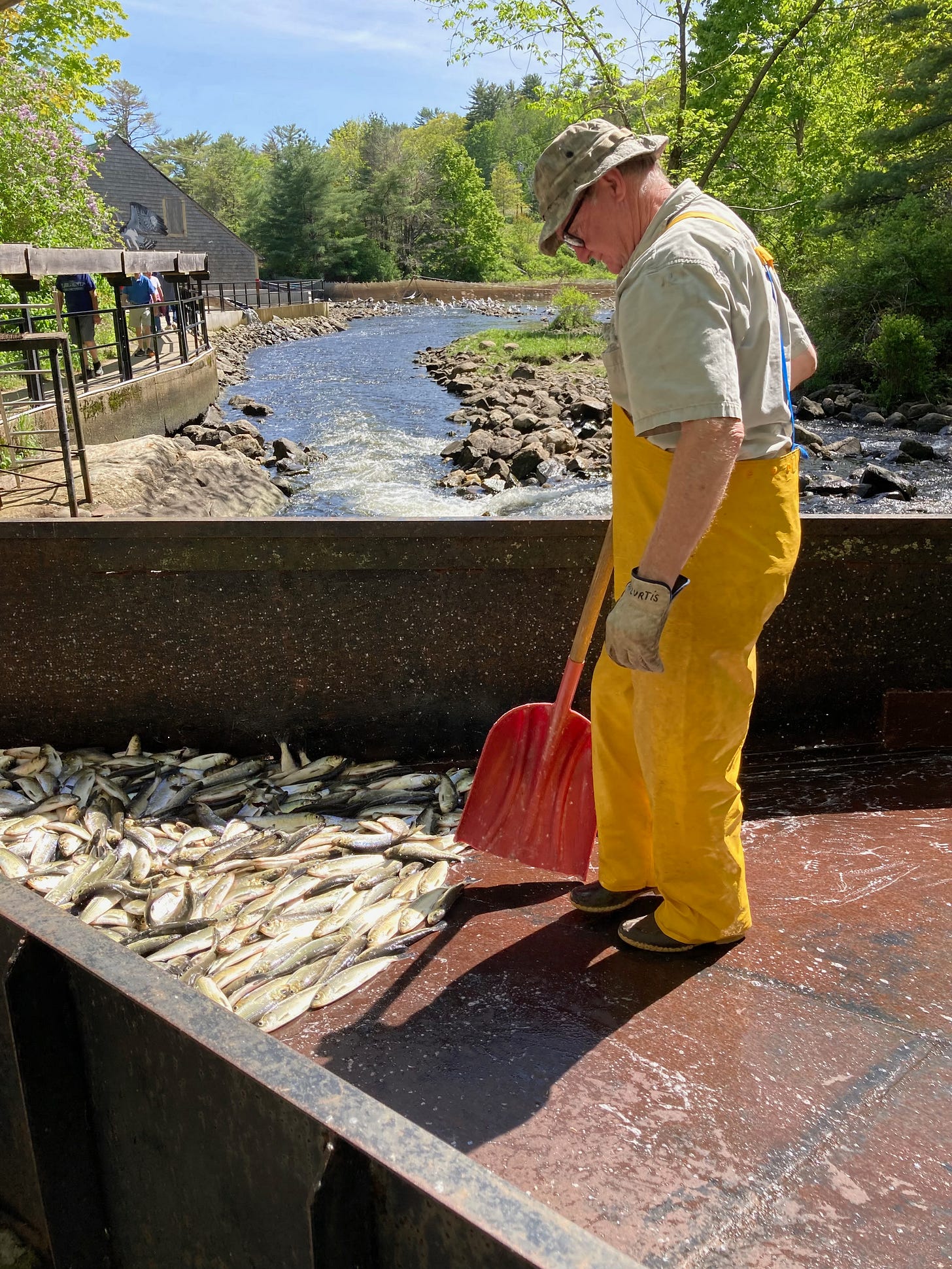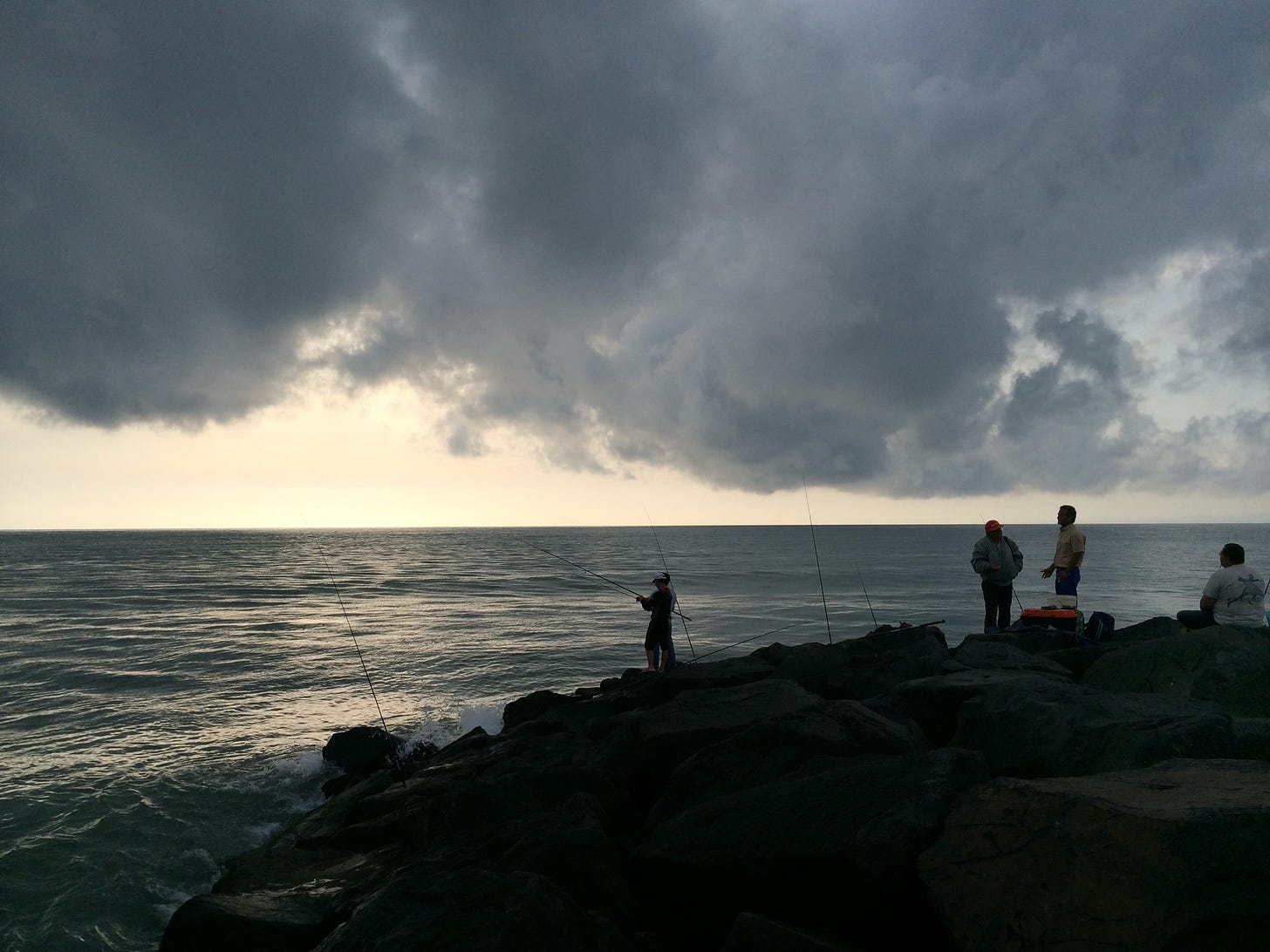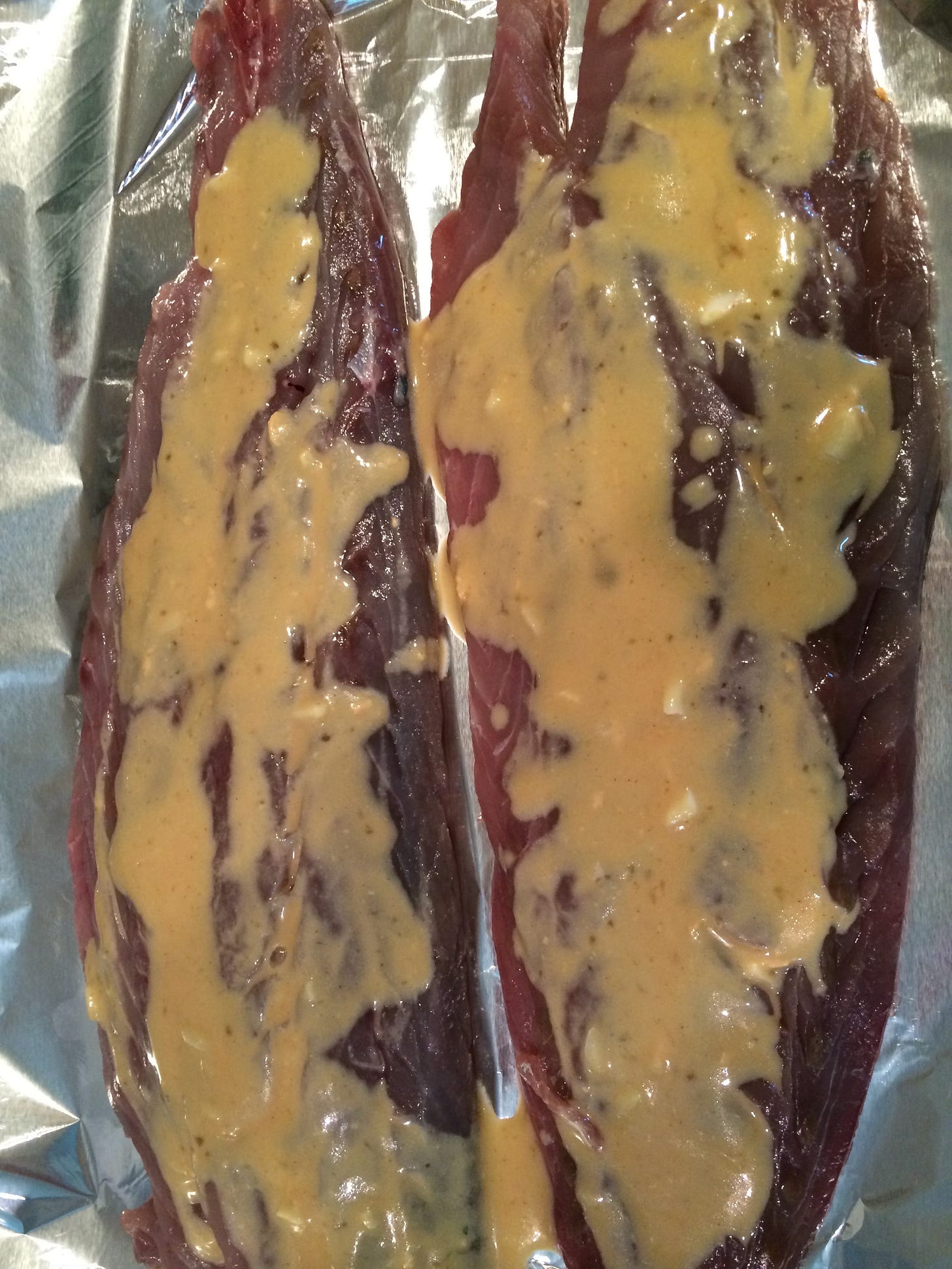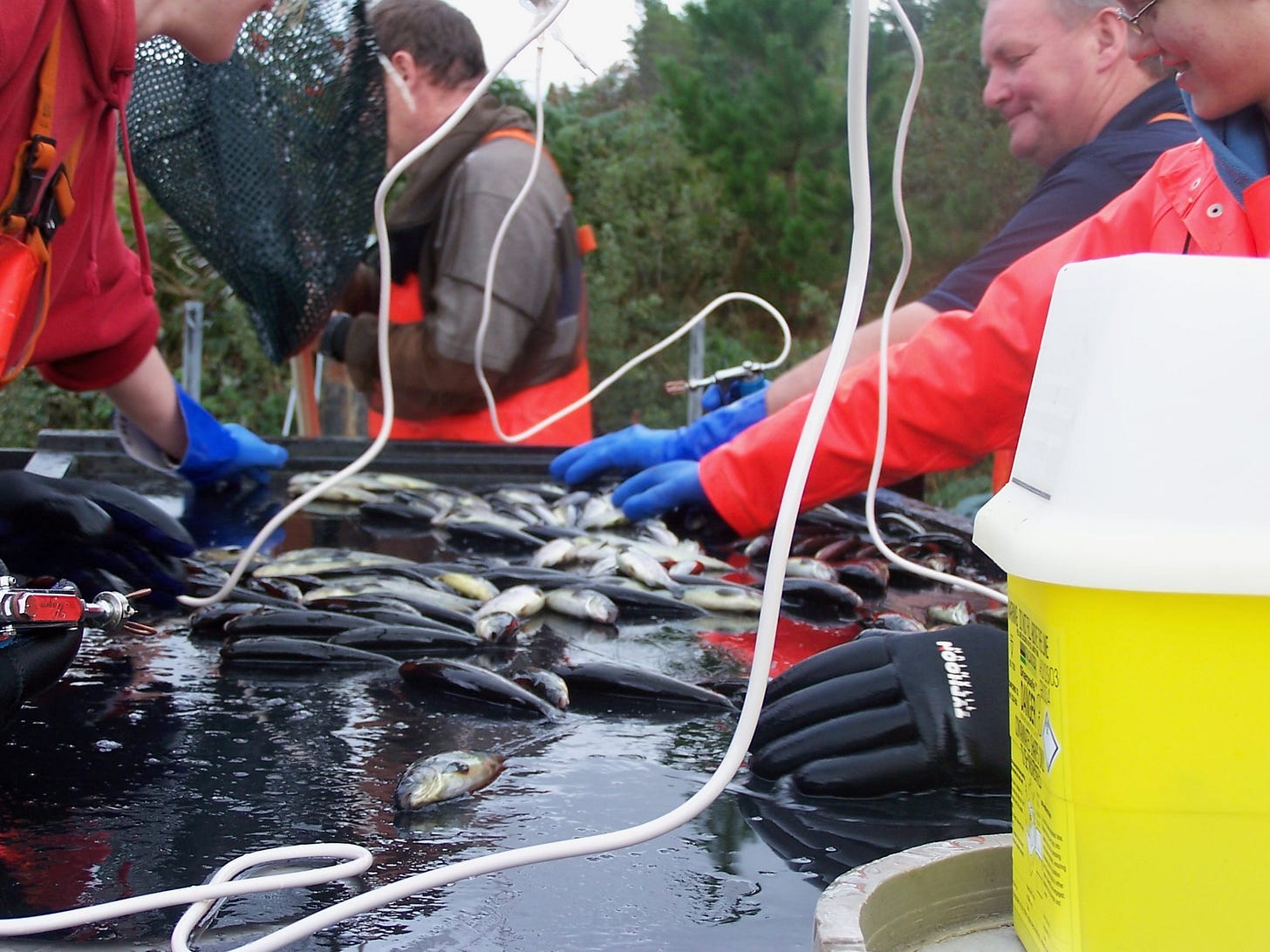Just tap that little heart in the upper left corner, would you please. It builds my creds.
In case you hadn’t noticed, we seem to be bombarded with advice about seafood. “Eat more fish!” they cry, nutritionists, dieticians, health advisors, and just plain food writers. Worried about protein? Eat more fish! Trying to manage your weight, up or down? Eat more fish! Troubled about the environmental costs of a red-meat diet? Eat more fish! Concerned about cholesterol, blood pressure, inflammation? Eat more fish!
And it’s true: Seafood in general is a very good thing, an awesome source of protein, and a prominent feature of a healthy Mediterranean diet. All fish is good for you but some fish are better than others. What Italians call pesce azzurro (blue fish) and what in English is called, less appealingly, fatty fish—meaning salmon, mackerel, bluefish, tuna, sardines, herring, trout, and anchovies—are rich in long-chain polyunsaturated omega-3 fatty acids, and what those multisyllabic words mean is fish that may prevent coronary heart disease, as well as being rich in calcium and vitamin B12. Fish score well on the traditional Mediterranean diet pyramid, far better than red meat. And even as meat consumption goes up all over the world, conscientious diners look to seafood as an alternative—at least two servings a week, says the American Heart Association, may lower the risk of heart disease.
All the more reason to up your intake.
So what’s stopping you? For many people, seafood of any kind has a reputation as hard to cook. I hope to convince you, with a couple of simple techniques, that cooking fish simply is not difficult, and these are techniques that you can adapt to just about any fish you find, whether in an accommodating market or, just possibly, one you’ve caught yourself.
If you don’t actually go fishing, or know someone who does, your best bet is a well-informed fish monger. This means a person behind the counter who can tell you where the fish comes from and when it was caught; often they will have ideas for how to cook it too. Most of our fish these days comes already gutted (an essential first step that should take place on the fishing boat), cut up into steaks or boned fillets, and often trimmed and skinned as well; in other words, ready for your skillet or your roasting pan. Since older recipes always advise checking the bright eyes and rosy gills for freshness, you will be out of luck. Just try that with a fish fillet! So, if you’re new to fish cookery, it’s a smart idea to shop around for the most knowledgeable fish sales person, keeping in mind that you might actually find that person in an anonymous big-box supermarket.
I however, living on the coast of Maine, have the great privilege of shopping at Jess’s Market in the South End of Rockland, Maine, where the owners provide me with chapter and verse about everything I see in their pristine fish case, from local halibut, scallops and squid to imported Scottish farmed salmon. If you’re traveling to Maine this summer, it’s worth stopping off to see and sample their
many wares. And yes, they also have lobster, live in tanks or cooked to scarlet perfection; moreover, they’ll ship it home if you don’t want to carry it yourself. You can find out more here.
One Fish: Bluefish
It was at Jess’s last week that I found lovely boned fillets of bluefish, each one weighing about half a pound, each one an abundant single serving, at a price of just $9.99 a pound. They came from farther south, off Massachusetts, where the highly migratory fish are running now. They won’t get to Maine waters until the seas warm up a bit, maybe not till early June. So, these blues are not exactly local, not yet, but Massachusetts is local enough for me. And the happy fact about bluefish is that they are widespread all across the world’s oceans.
For a lot of people, bluefish is an unlovely, unlovable fish but for those of us in the know, it’s one of the seasonal delights of the northwest Atlantic with flesh that is tender, meaty, tasty, and, like tuna, like mackerel, like salmon, just packed with those Omega-3 fatty acids. Sam Sifton at the New York Times called it “the pork shoulder of seafood,” in brief, the opposite of Dover sole, bluefish doesn’t require a delicate touch in the kitchen. The key is to get blues as fresh as possible, even to catch your own. Surf-casting for bluefish is a popular sport for anglers, especially when these voracious critters are swarming in frenzied schools as they pursue other, lesser species. It is a fish-eat-fish world out there, truly.
Blues is the simple title of a long-ago book by John Hersey, a prose poem to angling for these scrappy fish in the waters off Martha’s Vineyard when they are in their seasonal surge. Published in 1987, the book is a dialog between the Fisherman and the Stranger, and in the words of the long-ago New Yorker reviewer: "Blues is. . . about much more than the pleasures and techniques of fishing; it is, as Fisherman tells Stranger, about interconnections -- the ties between mankind and the natural world, among others."
That is something to think about.
I have, most regrettably, long since mislaid my copy of that remarkable book but I do remember that a recipe was attached to each of the twelve chapters, recipes, of course, for handling the much maligned fish in the kitchen. One in particular stood out for its utter simplicity and straightforward recognition of the fish’s reputation as oily and fishy, too much so for finicky palates. The mix of mustard and mayo, sharp and smooth, plus a good dose of lemon, cuts the fishy flavor so well that even the most reluctant fish-hater might be persuaded. You’ll see my directions below, after the lamentable but necessary paywall.
I came across a photo on the internet of a bluefish caught off Cape Hatteras in North Carolina that weighed nearly 32 pounds, said to be the world record for the species. But that was back in 1972 and the likes have not been seen since; still, NOAA assures us that bluefish are “not subject to over fishing,” so you can feel even more comfortable about this indulgence.
Two fish: Salmon
At the opposite extreme is Atlantic salmon, a wild fish that is perpetually at risk of extinction. The capture of wild Atlantic salmon is prohibited in much of the world, especially in the US and parts of Canada. (Some recreational salmon fishery is allowed in Canada but it is strictly regulated.) The wild population of this prized fish has been demolished, not just by over fishing but also by dams erected as far back as the 18th century, as well as by more recent pollution in rivers and streams where the anadromous fish spawn. Anadromous fish are those that spawn and hatch in fresh water, often in remote brooks and streams deep in interior forests far from the sea. As the fish mature, they move down through the watershed to the salty ocean where they make their home for between one and three years, sometimes even longer, before returning back up the rivers and streams of fresh water to their birthplace, where they spawn and start the cycle over again. It’s an extraordinary and deeply moving story, one that brings with it the understanding that long after we humans have completed our wreckage of the planet, salmon, like other natural phenomena, may well persist and revive, having paid good riddance to humankind.
Atlantic salmon (Salmo salar, the leaping salmon), gets its name from the prodigious energy these critters exhibit as they surge up raging fresh-water currents, leaping over rapids and waterfalls, in their springtime return to spawn. But you will not find that in any shop or on any restaurant menu. The Atlantic salmon available today is universally farmed. (Wild salmon, on the other hand, is Pacific salmon, Oncorhynncus, a very different kettle of fish.)
And, yes, I know a lot about farmed salmon. I have visited salmon farms in Chile and Scotland and New Brunswick, and spoken at length with farmers, marine biologists, industry representatives, and environmentalists. I know that salmon farming is controversial, that in the past some pretty unpleasant activities took place around farmed salmon, but I also know that more and more salmon farms are discovering a compelling market for sustainably raised fish. In fact, farmed salmon can be and often is a far more healthful choice, both for the environment and for your table, than pork, beef, or chicken, as those proteins are conventionally raised in the United States and elsewhere.
So keep that in mind as you check out the recipe for a delightful, healthful, and very pretty green-and-pink pasta dish, perfect for spring evenings or Sunday lunch on the kitchen porch when spring showers keep you out of the garden. It’s a simple question of combining spring greens (I used freshly sprouted kale, much more tender than the mature kale you’re perhaps used to) along with spring onions, green garlic, chopped chives, and, the key ingredient, quick-roasted salmon. Pasta water, from the rigatoni simmering on the stove top, helps make the sauce creamy enough to coat the stubby little chunks of pasta.
Like the oven-roasted bluefish, this is a very adaptable recipe, as you will see. Substitute another fish for the salmon (swordfish? halibut? cod? sea bass? maybe grouper, if you can find it?) and sub another green for the spring kale—broccoli rabe would make a fine choice, or collard, mustard, or turnip greens. You want something with good flavor and a firm texture—I would not suggest spinach, lovely as that is, because it might just disappear. Dandelion greens, if available, would be splendid!
Finally, as a sort of lagniappe, I include directions for an old favorite fish treatment that I first tasted at a famous old restaurant up a flight of steps in the big bazaar in Istanbul, and later found its near cousin in a Sicilian coastal trattoria—each separate serving of fish with a few vegetables and some savory bits like olives and capers, aromatic herbs, and of course olive oil, folded into a parchment or foil parcel for roasting, then served up in its own individual packet to be opened at the table, releasing its fantastic aromas to the eager assembly. This too is an easy way to deal with fish or any kind of seafood and moreover, it makes kitchen clean-up a piece of cake, with no skillets or roasting pans to scrub and nothing but the remains of the day to toss in the compost.
A brief word from our sponsor: I plan to be on vacation for the next few weeks, brought on by a combination of graduations, family birthdays, visiting friends, and, not least, a quick and unexpected trip to Italy, about which I shall report in detail when I get back.
Keep reading with a 7-day free trial
Subscribe to On the Kitchen Porch to keep reading this post and get 7 days of free access to the full post archives.









